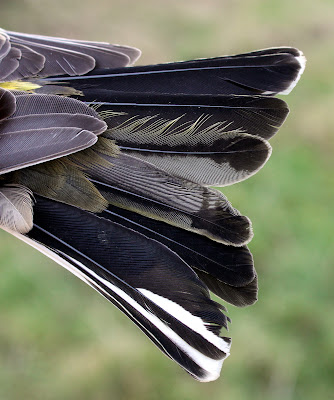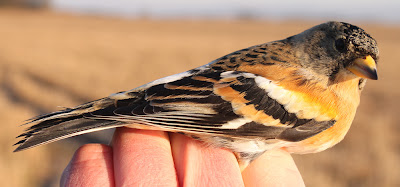Details came from the BTO of a Lesser Redpoll Y310191 which I caught on Rawcliffe Moss on 19th October 2012. It had been first ringed at Alfrick Pound, near Great Malvern, Worcestershire, 225 days earlier on 8th March 2012. The dates involved point to a spring migration to a spot somewhere north of Rawcliffe Moss and an autumn return to a location south of Worcestershire.
Lesser Redpoll - Gt Malvern to Out Rawcliffe
The repoll was one of 28 caught at Out Rawcliffe in October, a classic month of Lesser Redpoll migration south.
On October 20th a day after Y310191, I caught a Belgian ringed Lesser Redpoll, details of which are yet to be notified to me.
Lesser Redpoll
Talking of the BTO (British Trust for Ornithology), I was reading my BTO News just the other day and I see they are offering the opportunity to become a member until June 2013 for the princely sum of £1 by direct debit just
here.
Please think about joining the BTO. It is not necessary to participate in the many voluntary activities as anyone can simply join the BTO and support its work through the annual subscription fee. Considering all the good work the BTO does it is both amazing and mystifying to know there are bird watchers out there in the UK who are not members - so come on guys and gals, join today for only £1 - less than a cup of Starbucks. Plug over.
Rawcliffe was the destination this morning, with no time for ringing, just a wander around and a top up the feeders for another day. When I arrived the Little Owl was out in the morning sun, warming itself after the overnight frost. It wasn’t interested in turning round for a photo, just content with a sideways glance. Hopefully I’d have it on the way back.
Little Owl
On an expanse of stubble fields there’s a large and mobile flock of mainly finches, the numbers of birds building over the last few weeks culminating today in a count of 700/800 Chaffinch, 3+ Brambling, 70+ Skylark and 2 Meadow Pipit. From a hedgerow nearby I disturbed 3 Roe Deer which shot across the stubble, pausing only to look back briefly at me. The same hedgerow held 25+ Reed Bunting, 3 Yellowhammer and 45+ Tree Sparrow, 2 Redwing and a single Fieldfare. To the east I watched as c3000 Woodpigeons took flight, leaving in parties to make their way west and out to Pilling Moss.
Brambling
Roe Deer
There were more Reed Buntings and Chaffinches near the plantation, with 10/12 Goldfinch too, so I topped the feeders vowing to return another day.
My walk back to the car added 2 Snipe, 1 Mistle Thrush, 1 Great-spotted Woodpecker and 1 Kestrel.
The owl was still there in the sunshine, all puffed up to retain heat, but this time a little more obliging to the camera.
Little Owl
Little Owl
I drove back home alongside the river and via Lancaster Road where I added 50+ Fieldfare and similar numbers of Redwing. From the roadside I could see the elusive Hen Harrier of local fame patrolling the many fields on offer, and a mile or two towards Pilling a gang of people with cameras hoping for a glimpse.
An excellent morning of bird watching. More news and views soon on Another Bird Blog, so stay in touch.


































































.jpg)












